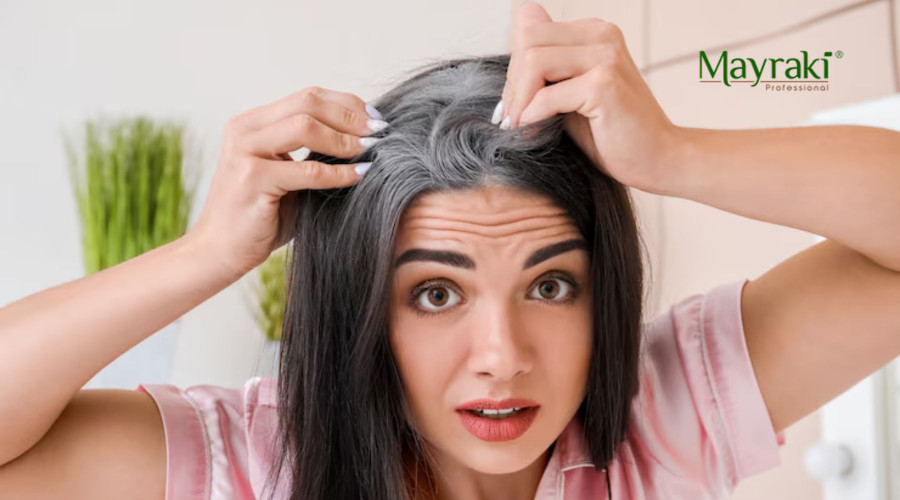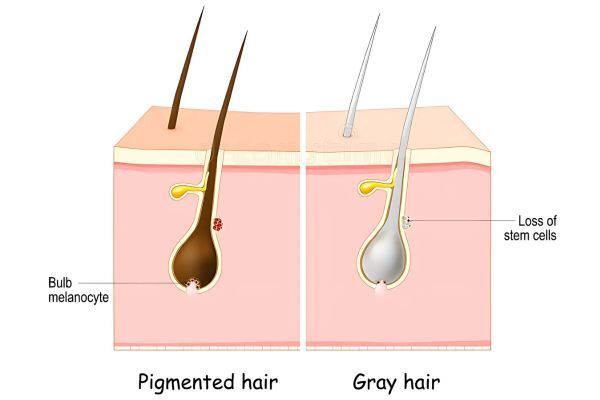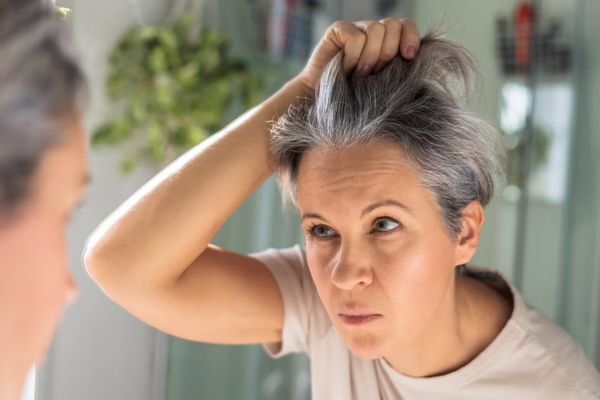The Science of Gray Hair Reversal: Can Herbal Compounds Reactivate Melanin Production?
Apr 12, 2025 | By Sophia L.

Gray hair has long been considered an inevitable sign of aging. However, emerging research in molecular biology and herbal pharmacology suggests it may be possible to restore natural hair color by targeting the biological mechanisms behind pigment loss — without using synthetic dyes.
At HairMayraki, we integrate scientific innovation with evidence-based botanical medicine to address gray hair from its root cause: melanocyte inactivity.
The Biology of Hair Pigmentation

Hair color is determined by the presence of melanin, produced by melanocytes located in the hair bulb adjacent to dermal papilla cells. These melanocytes transfer melanin to keratinocytes, which form the structure of the hair shaft. This melanin synthesis process is regulated by several key molecular pathways.
The most studied among them is the MC1R/MITF/tyrosinase axis:
- MC1R (Melanocortin 1 Receptor): A G-protein-coupled receptor on the melanocyte surface activated by alpha-MSH (α-melanocyte stimulating hormone).
- MITF (Microphthalmia-associated Transcription Factor): A master transcriptional regulator that promotes melanocyte survival and melanin gene expression.
- Tyrosinase: The rate-limiting enzyme in the melanin synthesis pathway, converting tyrosine into DOPA and subsequently into melanin.
“Melanin synthesis in melanocyte or melanoma cells is mainly regulated by the MC1R/MITF/tyrosinase-signaling pathway.”
— Journal of Advanced Pharmaceutical Technology & Research, 2020
Link to study
When melanocytes downregulate this pathway—either due to aging, oxidative stress, or genetic predisposition—the result is melanin depletion and visible gray or white hair, clinically referred to as canities.
Can This Process Be Reversed?
Traditional hair dye merely conceals the absence of melanin. However, an alternative approach—melanocyte reactivation—aims to restore natural melanin production at the follicular level.
Recent developments in botanical pharmacology have identified a number of herbs with the ability to stimulate melanogenesis via MC1R activation, promote melanocyte regeneration, and enhance intracellular tyrosinase activity.
One such example is Polygonum Multiflorum Thunb. (He Shou Wu), widely used in Traditional Chinese Medicine (TCM) and now backed by modern pharmacological studies.
Polygonum Multiflorum has been shown to stimulate melanogenesis in B16F10 melanocytes by upregulating tyrosinase, TRP-1, and MITF gene expression.
— Phytomedicine Journal, 2015
The Herbal Science Behind Mayraki's Anti-Gray Hair Color Restoring Treatment

Our Anti-Gray Hair Color Restoring Treatment is formulated based on molecular-level targeting of melanin pathways, combined with traditional knowledge of melanocyte-supporting herbs.
It includes a synergistic blend of:
1. Polygonum Multiflorum Root Extract
- Scientific role: Induces MC1R expression and increases tyrosinase activity in melanocytes.
- Traditional use: Blood and kidney tonic in TCM; historically used for reversing premature graying.
2. Carthamus Tinctorius (Safflower) Extract
- Scientific role: Inhibits DHT, improves microvascular blood flow to the follicle, promotes expression of melanogenic factors.
- Clinical insight: Shown to enhance pigmentation and prolong the anagen phase of the hair cycle.
3. Ligustrum Lucidum Extract
- Scientific role: Contains oleanolic acid and flavonoids that protect melanocytes from oxidative damage.
- Traditional use: TCM liver and kidney tonic; used to improve hair vitality and pigment.
4. Coffea Arabica Extract
- Scientific role: Stimulates hair shaft elongation and keratin synthesis; improves nutrient transport via vasodilation.
- Note: Its caffeine content may also stimulate dermal papilla cell proliferation.
5. Galla Rhois (Gallnut) Extract
- Scientific role: High in gallotannins and polyphenols with antioxidant, antimicrobial, and anti-aging effects.
- Function: Protects hair follicles and melanin-producing cells from UV-induced stress.
6. Biota Orientalis Leaf Extract
- Scientific role: Contains hinokitiol and essential oils with antibacterial and sebum-regulating properties.
- Impact: Promotes a healthier scalp environment, improving follicular regeneration and pigment distribution.
7. Castor Oil
- Scientific role: Enhances follicular nourishment and moisture retention, supports regrowth of pigmented hair.
- Traditional use: A cornerstone oil in Ayurvedic and folk medicine for scalp healing and density restoration.
Clinical Potential: What Results to Expect

Unlike synthetic dyes that deliver instant masking, melanin-stimulating treatments require biological remodeling over time.
Typical user observations include:
- Weeks 1–4: Reduced dryness, scalp health improvements
- Weeks 4–8: Gradual darkening of previously gray strands from root to tip
- Weeks 8–12: Increased density, thickness, and visible repigmentation in newly growing hair
This treatment works best on early-stage or partial gray hair, where melanocytes are dormant (not destroyed).
Where to Buy
If you're looking for a non-toxic, scientifically informed, herbal alternative to covering gray hair, our Mayraki Anti-Gray Hair Color Restoring Treatment offers a research-backed pathway toward melanin recovery and hair color restoration.
It’s free from artificial dyes, parabens, SLS, and synthetic fragrance — safe for long-term use on sensitive scalps.
? Click here to shop the treatment
Final Thoughts
The reversal of gray hair is no longer an unscientific dream — it's a process grounded in melanocyte biology and supported by emerging botanical research. By leveraging herbs like Polygonum Multiflorum and Carthamus Tinctorius, which influence key genetic pathways (MC1R/MITF/tyrosinase), it’s now possible to support the body in naturally restoring hair pigment from within.
If you're exploring options beyond conventional dye, consider aligning with the science of the melanin pathway — your follicles may just need the right signal to bring color back.




